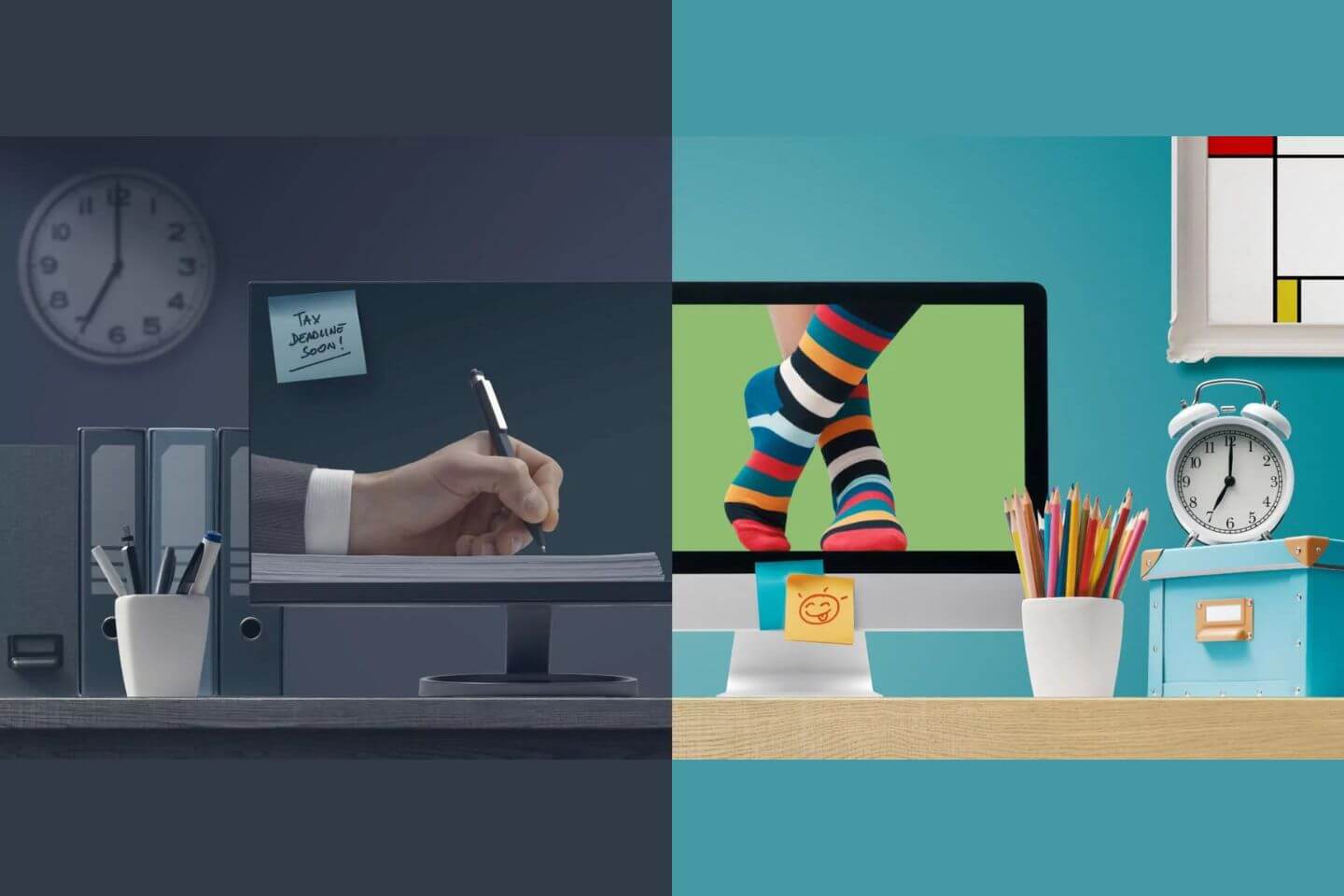Identifying your work style can dramatically improve how you approach your career. Knowing ‘what is your work style‘ reflects not just your work habits, but the essence of your professional identity. This article demystifies work styles, explaining how to pinpoint your very own style and use that knowledge to excel in your job. Discover your unique working pattern and transform the way you view productivity and teamwork.
Key Takeaways
- Recognizing and embracing your personal work style—be it independent, cooperative, proximity, supportive, logical, detail-oriented, idea-oriented, or adaptive—can empower you to leverage your strengths and identify areas for development for career growth.
- Understanding your own working style and those of your colleagues fosters improved communication, collaboration, and productivity, and helps create a harmonious and efficient work environment.
- Identifying your work style involves introspection, seeking constructive feedback from others, and possibly using personality assessments, all of which contribute to personal and professional development and adaptability in various work settings.
Defining Work Styles

Work styles are more than just how we perform our daily tasks. They are unique expressions of our personality traits, professional strengths, and natural work approaches in action. When we talk about work styles, we’re referring to the methods we use to:
- Complete tasks
- Solve problems
- Communicate
- Collaborate with others
Recognizing your work style is empowering. It’s like having a road map that highlights your strengths and areas for improvement, enabling you to navigate your professional journey more efficiently. Whether your work style leans towards independent working or a more team-oriented approach, recognizing it can help you harness your strengths more effectively and work on your weaknesses.
The Importance of Knowing Your Work Style
Recognizing your work style is more than just a self-awareness exercise. It is a key stepping stone towards achieving your career goals and choosing work environments that enable you to thrive. When you know your work style, it becomes easier to understand and collaborate with your team members, contribute to your organization’s success, and enhance communication across the board.
Moreover, knowing your own working style can help increase your productivity by leveraging your individual strengths. It can also help you recognize personal biases that could be potential hurdles in your work life, enabling you to overcome them and reach your full potential. Understanding and adapting to different work styles within your team can lead to a harmonious work environment and improved team effectiveness.
A final reason to know your working style may come up in the job application process. A common question asked at the job interview is “What is your working style?” You’ll impress the hiring manager if you answer interview questions of this type with solid information based on tests or assessments that you previously completed.
Common Work Style Categories

Work styles can be as diverse as people themselves, but they can be broadly categorized into seven main types. Identifying your preferred work style can help you understand how you work best and adapt to different situations. The main work styles are:
- Independent
- Cooperative
- Proximity
- Supportive
- Logical
- Detail-oriented
- Idea-oriented/big-picture thinkers
- Adaptive
Let’s delve deeper into each of these categories and explore their characteristics, strengths, and challenges.
Independent Workers
Independent workers are the self-starters of the professional world. They are efficient, disciplined, and highly productive, relying on logical thinking and self-reliance to navigate their work autonomously. Whether you’re a visionary, entrepreneur, creative, or scientist, if you prefer managing tasks on your own and bringing deep concentration to difficult tasks and projects, you might just have an independent work style.
However, every work style has its challenges. For those who work independently, challenges may include dealing with team dynamics and communication, and subsequently lead to feelings of isolation. For those who work solo, they will find that they perform best in environments giving them their own space, allow for greater focus, and have fewer distractions. Coaching independent workers effectively requires a careful balance of treating them as professionals and granting them the creative control they need to excel.
Cooperative Workers
In contrast to independent workers, those with cooperative working styles thrive on team dynamics. They prioritize consensus and find energy in collaborative efforts with others. If you’re someone who enjoys working closely with others, loves open feedback, and robust idea exchanges, you might have a cooperative work style.
Cooperative workers are known for their strong communication skills and interpersonal abilities. However, while they excel in partnership, they might find it challenging to perform at their best independently. To leverage the strengths of cooperative workers, it’s essential to capitalize on their team-oriented skills and provide opportunities for collaborative growth.
Proximity Workers
Proximity workers strike a middle ground between an independent working style and a cooperative work style, thus embodying the concept of proximity working styles. They are adaptable and can excel in many business areas, from management to marketing, due to their versatility. If you’re someone who enjoys working solo but also values the benefits of socializing and receiving help from teammates, you might have a proximity work style.
Balancing solo work with collective success is a hallmark of the proximity working style. Proximity workers can shift seamlessly between various roles without sacrificing the benefits of collaboration, making them a valuable asset to any team.
Supportive Workers
Supportive workers are the glue that holds teams together. They are expressive, emotionally aware, and prioritize forming deep connections with their colleagues. If you’re someone who enjoys facilitating team interactions, resolving conflicts, and helping others, you might have a supportive work style. In fact, supportive working styles are essential for fostering a positive and collaborative work environment.
Supportive workers are known for their emotional intelligence, self-awareness, and excellent collaboration skills. However, they might encounter challenges when it comes to maintaining focus and making tough decisions. Despite these challenges, their empathetic approach and focus on teamwork make them integral to any team, especially when it comes to project planning and fostering a positive work environment.
Logical
Logical workers bring a systematic and analytical approach to their tasks. They are known for their goal setting, reasoning abilities, and efficiency in time management and task execution.
If you have a logical work style, you:
- Enjoy working methodically and systematically
- Excel in roles that require logical thinking and structured problem-solving
- Are an excellent problem solver
Detail-Oriented Workers
Detail-oriented workers excel at:
- Managing risks
- Providing order and stability
- Meticulous approach to complicated tasks
- Love for working with details
If you’re someone who enjoys strategic planning, thoughtful execution, and ensuring accuracy, you might have a detail-oriented work style.
However, detail-oriented workers might require more extensive and precise feedback to be effective in their roles. Hiring managers often find these individuals shining in roles that require precision. Although the job requires a thorough approach, but they must be mindful not to get bogged down in the details and lose sight of the bigger picture when crafting a job description, especially when the job description specifically calls for a detail-oriented person.
Idea-Oriented / Big-Picture Thinkers
Big-picture thinkers are the visionaries of the work world. They are adept at quickly grasping the totality of a situation and are great at conceptualizing overarching visions. If you’re someone who is optimistic, able to inspire others, and effective at facilitating change, you might have a big-picture work style.
However, those who always look at the big picture might struggle with structure and follow-up, as they often overlook the details. Nevertheless, their alignment with the company’s vision and their ability to integrate ideas and initiate innovative strategies make them invaluable in any team.
Adaptive Workers
Adaptive workers are the chameleons of the work world. They are quick to provide and receive feedback, innovate, and think outside the box. If you’re someone who builds strong rapport, is idea-oriented, and thrives on change, you might have an adaptive work style.
But be aware, adaptive workers might struggle in remote work environments, which may not always provide the dynamic conditions they thrive in. To enhance their adaptability, they often invest in personal development, explore new roles, and seek training to grow comfortable with change.
Identifying Your Own Work Style

Now that we’ve explored the various working styles, let’s delve into how you can identify your own work style. This thought process involves three key steps: self-reflection, seeking feedback, and utilizing assessments.
Let’s explore each of these in more detail.
Self-Reflection
Self-reflection is a powerful tool for identifying your predominant work style. By considering past projects and circumstances where you felt most productive or satisfied, you can gain insights into your work style.
To guide your self-reflection, consider your communication preferences, your role in team projects, and what activities engage and satisfy you at work. Understanding whether you’re more energized by brainstorming or implementation can aid in identifying the most suitable work environment and tasks that align with your natural tendencies, especially when handling multiple projects.
Seek Feedback
Feedback from colleagues, project managers, and supervisors can be crucial to increase self-awareness and recognize facets of your work style that you may not identify on your own. By seeking feedback from various hierarchical levels, including managers, peers, and subordinates, you can get a rounded perspective of how your own work ethic and style is perceived across the organization.
Here are some tips to get the most out of feedback:
- Select individuals who are familiar with your work and can provide relevant and actionable feedback.
- Ask open-ended questions to encourage more detailed and insightful feedback.
- Consider asking for feedback on specific aspects of your work style to gain unique insights.
Use Assessments
Work style assessment tools can be beneficial for identifying your work style. They can provide valuable insights that help you understand your strengths and areas for improvement. Here are just a sample of the types of tools available:
Work Style Test by Psychology Today. The test is free and should take about 15 minutes to complete. Upon completion, you’ll receive a snapshot summary of your results. A full report will cost you $9.95.
The Teal Work-Styles Assessment claims it is 100% free. It requires you to create an account to begin. While nothing describes what the assessment covers, there are several graph examples shown. It appears to keep asking one to take additional tests or sign up for other programs, likely charging fees at some point.
Free workstyle assessment quiz from Clockwise. This is one of the simplest tools on the Internet. It includes a 6 question quiz right on the web page. There is a quadrant with four different workstyle types: Logical, Organized, Supportive, and Big-Picture. Each style lists strengths, weaknesses, and whom individuals with that style pair well with.
Other popular assessments include the DiSC Personality Test, Myers-Briggs Type Indicator, Revised NEO Personality Inventory, and SHL Occupational Personality Questionnaire. After taking an assessment, consider sharing your results with your supervisor. It could help to better understand your strengths and address weaknesses in your work approach.
Adapting Your Work Style to Different Environments

Once you’ve identified your work style, the next step is learning to adapt it to different environments. This involves staying informed about changes within your industry, responding to shifts in work responsibilities, and understanding diverse work styles.
Whether you’re a team player, an independent or logical worker, or a detail-oriented individual, understanding your strengths and weaknesses can help you adapt to different situations. Encouraging an exchange of new ideas and perspectives among team members can also foster a culture of adaptability and openness, contributing to a positive company culture.
Collaborating with Diverse Work Styles

Collaborating with diverse work styles can seem like a daunting task, but understanding individual and team members’ work styles and communication style can vastly improve support for job performance and result in a more dynamic and cohesive team. Respecting communication preferences of each team member and assigning tasks based on their work style strengths can lead to increased productivity and satisfaction.
However, it’s also important to understand that conflict styles vary among different work styles, influencing how they handle disagreement. Recognizing these differences and managing conflicts efficiently can contribute to a team’s creative problem-solving abilities and overall effectiveness.
Summary
Understanding and adapting your work style is a journey of self-discovery that can enhance your productivity, communication, and collaboration skills. By identifying your work style, understanding its strengths and weaknesses, and learning to adapt it to different environments, you can unlock your potential and propel your career to new heights. Remember, there’s no ‘one-size-fits-all’ approach to work styles. Embrace your unique work style and use it to make a positive impact in your professional life.
Frequently Asked Questions
What is a work style?
A work style is the combination of habits, preferences, and techniques individuals use in their professional settings, shaped by personality traits, strengths, and natural approaches.
Why is it important to know your work style?
Knowing your work style can improve collaboration, communication, and career advancement. It can also also help you identify your strengths and weaknesses for personal and professional growth.
How can I identify my work style?
To identify your work style, take time for self-reflection, seek feedback from colleagues and supervisors, and consider using assessments to gain insight. This will help you understand your preferences in the workplace.
How can I adapt my work style to different environments?
Adapting your work style to different environments involves staying informed about industry changes, responding to shifts in work responsibilities, and understanding the diverse work styles of your colleagues. Stay flexible and open-minded to thrive in various work settings.
How can I collaborate with people having diverse work styles?
To effectively collaborate with those that have differing work styles from your own, it’s important to understand their individual preferences. Respect their communication style, play to their strengths, and work on handling conflicts efficiently. This will help create a more cohesive and productive team dynamic.


